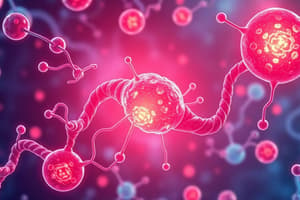Podcast
Questions and Answers
Which amino acids are classified as essential amino acids that the organism cannot synthesize?
Which amino acids are classified as essential amino acids that the organism cannot synthesize?
- Valine, Leucine, Methionine
- Isoleucine, Methionine, Leucine
- Arginine, Threonine, Phenylalanine
- Histidine, Lysine, Tryptophan (correct)
What is the primary source of free amino acids in the amino acid pool?
What is the primary source of free amino acids in the amino acid pool?
- Degradation of lipids
- Hydrolysis of polysaccharides
- Synthesis from carbohydrate precursors
- Hydrolysis of dietary or tissue protein (correct)
How does the degradation rate of proteins vary?
How does the degradation rate of proteins vary?
- It depends solely on the presence of essential amino acids
- It is influenced by the size of the protein only
- It is uniform across all proteins
- It varies based on individual protein characteristics (correct)
What is the expected half-life of liver enzymes compared to other proteins like hemoglobin?
What is the expected half-life of liver enzymes compared to other proteins like hemoglobin?
Which statement correctly describes the relationship between dietary protein intake and endogenous protein proteolysis?
Which statement correctly describes the relationship between dietary protein intake and endogenous protein proteolysis?
What role do abnormal and damaged proteins play in cellular function?
What role do abnormal and damaged proteins play in cellular function?
What is the consequence of the accumulation of abnormal and defective proteins?
What is the consequence of the accumulation of abnormal and defective proteins?
Why is the degradation of inducible enzymes important?
Why is the degradation of inducible enzymes important?
How does the rate of turnover relate to proteins functioning outside the cell?
How does the rate of turnover relate to proteins functioning outside the cell?
What is one of the primary functions of protein degradation in response to physiological changes?
What is one of the primary functions of protein degradation in response to physiological changes?
In the context of protein metabolism, what role do gluconeogenic precursors play?
In the context of protein metabolism, what role do gluconeogenic precursors play?
What potential hazard arises from the inability to degrade defective proteins?
What potential hazard arises from the inability to degrade defective proteins?
What is a necessary action taken when regulatory proteins are no longer needed due to changing physiological conditions?
What is a necessary action taken when regulatory proteins are no longer needed due to changing physiological conditions?
Which enzyme is primarily responsible for activating trypsinogen in the digestion of proteins?
Which enzyme is primarily responsible for activating trypsinogen in the digestion of proteins?
What triggers the secretion of cholecystokinin from the duodenum?
What triggers the secretion of cholecystokinin from the duodenum?
What denotes proteins that are preferentially degraded, commonly due to chemical alterations?
What denotes proteins that are preferentially degraded, commonly due to chemical alterations?
Which structure recognizes ubiquitinated proteins and assists in their unfolding for degradation?
Which structure recognizes ubiquitinated proteins and assists in their unfolding for degradation?
Which enzyme acts on extracellular proteins within lysosomal environments?
Which enzyme acts on extracellular proteins within lysosomal environments?
What is the primary role of pancreatic proteases in the digestive system?
What is the primary role of pancreatic proteases in the digestive system?
Which of the following is a major outcome of proteins containing PEST sequences?
Which of the following is a major outcome of proteins containing PEST sequences?
What activates pancreatic acinar cells to release zymogens?
What activates pancreatic acinar cells to release zymogens?
What characterizes nonhepatic disease in terms of plasma enzyme levels?
What characterizes nonhepatic disease in terms of plasma enzyme levels?
What is the first step of amino acid catabolism?
What is the first step of amino acid catabolism?
Where does oxidative deamination primarily occur in the body?
Where does oxidative deamination primarily occur in the body?
What is a result of oxidative deamination?
What is a result of oxidative deamination?
Which of the following metabolic processes involves the transfer of an amino group to an α-keto acid?
Which of the following metabolic processes involves the transfer of an amino group to an α-keto acid?
What is the primary role of pepsin in the digestive process?
What is the primary role of pepsin in the digestive process?
Which of the following amino acids has the highest gradient for active transport?
Which of the following amino acids has the highest gradient for active transport?
What mechanism does the COAL system utilize for the uptake of amino acids?
What mechanism does the COAL system utilize for the uptake of amino acids?
Which statement about the transport of amino acids is correct?
Which statement about the transport of amino acids is correct?
What is pepsinogen's role in the stomach?
What is pepsinogen's role in the stomach?
Which of the following describes the nature of peptic hydrolysis of proteins?
Which of the following describes the nature of peptic hydrolysis of proteins?
What kind of enviroment does active transport systems create for pepsin's function?
What kind of enviroment does active transport systems create for pepsin's function?
Which of the following systems is Na+-independent concerning amino acid transport?
Which of the following systems is Na+-independent concerning amino acid transport?
Flashcards are hidden until you start studying
Study Notes
Amino Acid Pool
- Comprises free amino acids distributed throughout the body.
- Amino acids are released by hydrolysis of dietary or tissue proteins.
- Essential amino acids cannot be synthesized and include:
- Histidine
- Lysine
- Threonine
- Isoleucine
- Methionine
- Tryptophan
- Leucine
- Phenylalanine
- Valine
- Arginine
Endogenous Protein Proteolysis
- Continuous breakdown of body proteins results in free amino acids.
- Degradation rates differ among individual proteins:
- Liver enzymes have half-lives of a few hours.
- Red blood cells (hemoglobin) last approximately 120 days.
- Structural proteins like collagen have long life spans.
Inputs for Amino Acids
- Derived from dietary protein and proteolysis of cellular proteins.
- Factors influencing protein degradation rates:
- Proteins serve as long-term energy storage and provide gluconeogenic precursors.
- Degradation removes abnormal or damaged proteins to maintain cell function.
- Metabolic activity regulation requires the degradation and replacement of specific regulatory proteins.
Protein Turnover
- Rapidly degraded proteins function outside the cell, with half-lives from hours to days (e.g., pancreatic enzymes).
- Degradation process includes:
- Stomach pepsin acting on large polypeptides.
- Pancreatic proteases further breaking down peptides into oligopeptides and amino acids.
Release and Activation of Zymogens
- Zymogens are activated by enzymes such as enteropeptidase.
- Key hormones like cholecystokinin and secretin influence pancreatic acinar cells for enzyme secretion.
- Trypsinogen is converted into trypsin by the cleavage of a hexapeptide.
Proteolytic Enzymes and Degradation Systems
- The 26S proteasome degrades endogenous proteins.
- The 19S cap recognizes and unfolds ubiquitinated proteins for degradation.
- Lysosomal enzymes target extracellular proteins for breakdown.
Signals for Protein Turnover
- Preferential degradation of chemically altered proteins, particularly those oxidized.
- Proteins with PEST sequences are targeted for degradation due to their composition of proline, glutamic acid, serine, and threonine.
- Acidic environments enhance pepsin activity for protein digestion.
Transport Mechanisms for Amino Acids
- Active transport systems create a gradient, moving amino acids from low to high concentration spaces.
- COAL system facilitates uptake of cystine and dibasic amino acids such as ornithine, arginine, and lysine.
- Na+-dependent luminal transport and Na+-independent contraluminal transport methods.
α-Amino Groups and Nitrogen Disposal
- Protect amino acids from oxidative breakdown by keeping them locked within the structure.
- Transamination is the first step in amino acid catabolism, transferring an amino group to an α-keto acid, generating a new amino acid.
- Oxidative deamination occurs primarily in the liver and kidney, releasing ammonia as a waste product.
Studying That Suits You
Use AI to generate personalized quizzes and flashcards to suit your learning preferences.





